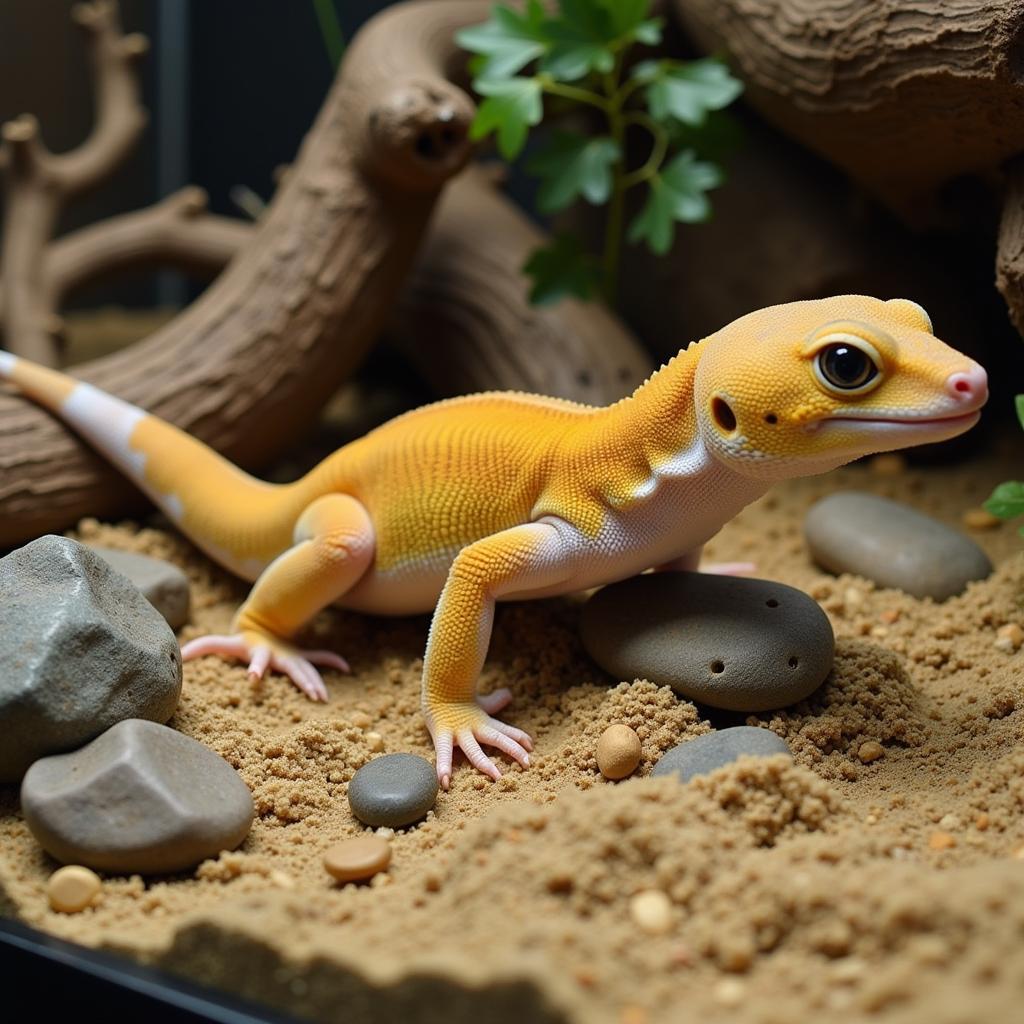African Fat Tailed Gecko Care: A Comprehensive Guide
African fat tailed geckos are becoming increasingly popular pets due to their docile nature, manageable size, and unique appearance. Providing proper African Fat Tailed Gecko Care is essential for their well-being and longevity. This guide covers everything you need to know to ensure your gecko thrives.
Understanding Your African Fat Tailed Gecko’s Needs
Like all reptiles, african fat tailed geckos have specific environmental and dietary requirements that must be met for them to flourish. Understanding these needs is the first step in becoming a responsible gecko owner. These fascinating creatures, native to West Africa, thrive in warm, slightly humid environments. They also require a specific diet and a properly furnished habitat to mimic their natural environment.
Providing the right temperature gradient is crucial for your gecko’s health. They need a basking spot of around 90°F (32°C) and a cooler side of the enclosure maintaining approximately 75°F (24°C). This allows them to thermoregulate effectively. Humidity levels should ideally be between 60-70%, which can be achieved by misting the enclosure regularly or using a humid hide.
Setting Up the Perfect African Fat Tailed Gecko Setup
Creating a suitable african fat tailed gecko setup is paramount for your gecko’s health and happiness. A 10-gallon tank is sufficient for a single gecko, while a 20-gallon long tank is recommended for a pair. Avoid housing multiple males together as they can become territorial. The substrate should be a mix of reptile-safe soil and sand, allowing for burrowing, which is a natural behavior for these geckos.
Hide boxes are essential for your gecko to feel secure. Provide at least two hides, one on the warm side and one on the cool side of the enclosure. A shallow water dish should always be available, providing fresh, clean water. Enrichment items such as rocks, branches, and fake plants can further enhance the environment and encourage natural behaviors.
“A well-designed enclosure not only meets the gecko’s physical needs but also stimulates its mental and emotional well-being,” says Dr. Anika Kimambo, a renowned herpetologist specializing in African reptiles. “Providing a stimulating environment helps prevent stress and promotes a healthy, active lifestyle for your gecko.”  African Fat Tailed Gecko in Terrarium
African Fat Tailed Gecko in Terrarium
Feeding Your African Fat Tailed Gecko
African fat tailed geckos are insectivores, meaning their diet primarily consists of insects. Crickets and mealworms are readily available and make up the staple diet. These insects should be gut-loaded with nutritious food before being offered to your gecko. Dusting the insects with calcium and vitamin D3 supplements is also crucial for preventing metabolic bone disease.
How often should you feed your gecko? Juveniles should be fed every day or every other day, while adults can be fed two to three times a week. It’s important to remove any uneaten insects after a few hours to prevent them from stressing your gecko.
Common Health Concerns
While generally hardy, african fat tailed geckos can be susceptible to certain health issues. One common problem is impaction, which can occur if the gecko ingests substrate while hunting. Using a shallow dish for food can help prevent this. Another potential issue is shedding problems, which can be caused by low humidity. Ensure proper humidity levels and provide a humid hide to aid in shedding.  African Fat Tailed Gecko Eating Insects
African Fat Tailed Gecko Eating Insects
“Regular monitoring of your gecko’s behavior and appearance is vital for early detection of any health problems,” advises Dr. Kwame Asante, a veterinarian with extensive experience in reptile care. “If you notice any changes in appetite, activity levels, or shedding, consult a reptile veterinarian promptly.”
Conclusion
Providing proper african fat tailed gecko care involves creating a suitable environment, offering a balanced diet, and monitoring for potential health problems. By following the guidelines outlined in this guide, you can ensure your african fat tailed gecko lives a long, healthy, and fulfilling life. Remember that responsible pet ownership requires commitment and dedication to meeting your gecko’s needs. african fat tailed gecko care is rewarding and enriching.
FAQ
- What is the ideal temperature for an African Fat Tailed Gecko?
- What should I feed my African Fat Tailed Gecko?
- How often should I clean my gecko’s enclosure?
- How can I tell if my gecko is healthy?
- Can I handle my African Fat Tailed Gecko?
- What substrate is best for African Fat Tailed Geckos?
- How can I tell the sex of my African Fat Tailed Gecko?
Common Situations and Questions:
- My gecko isn’t eating: This could be due to stress, incorrect temperatures, or illness. Check your setup and consult a vet if the issue persists.
- My gecko is shedding poorly: Increase humidity and provide a humid hide.
- My gecko is lethargic: This could indicate illness or improper temperatures.
Further Reading:
For more information on related topics, you can check out our articles on the african house gecko and african decor for sale. We also have some interesting african hides for sale.
Contact Us
For any assistance, please contact us: Phone: +255768904061, Email: kaka.mag@gmail.com or visit us at: Mbarali DC Mawindi, Kangaga, Tanzania. We have a 24/7 customer support team.

